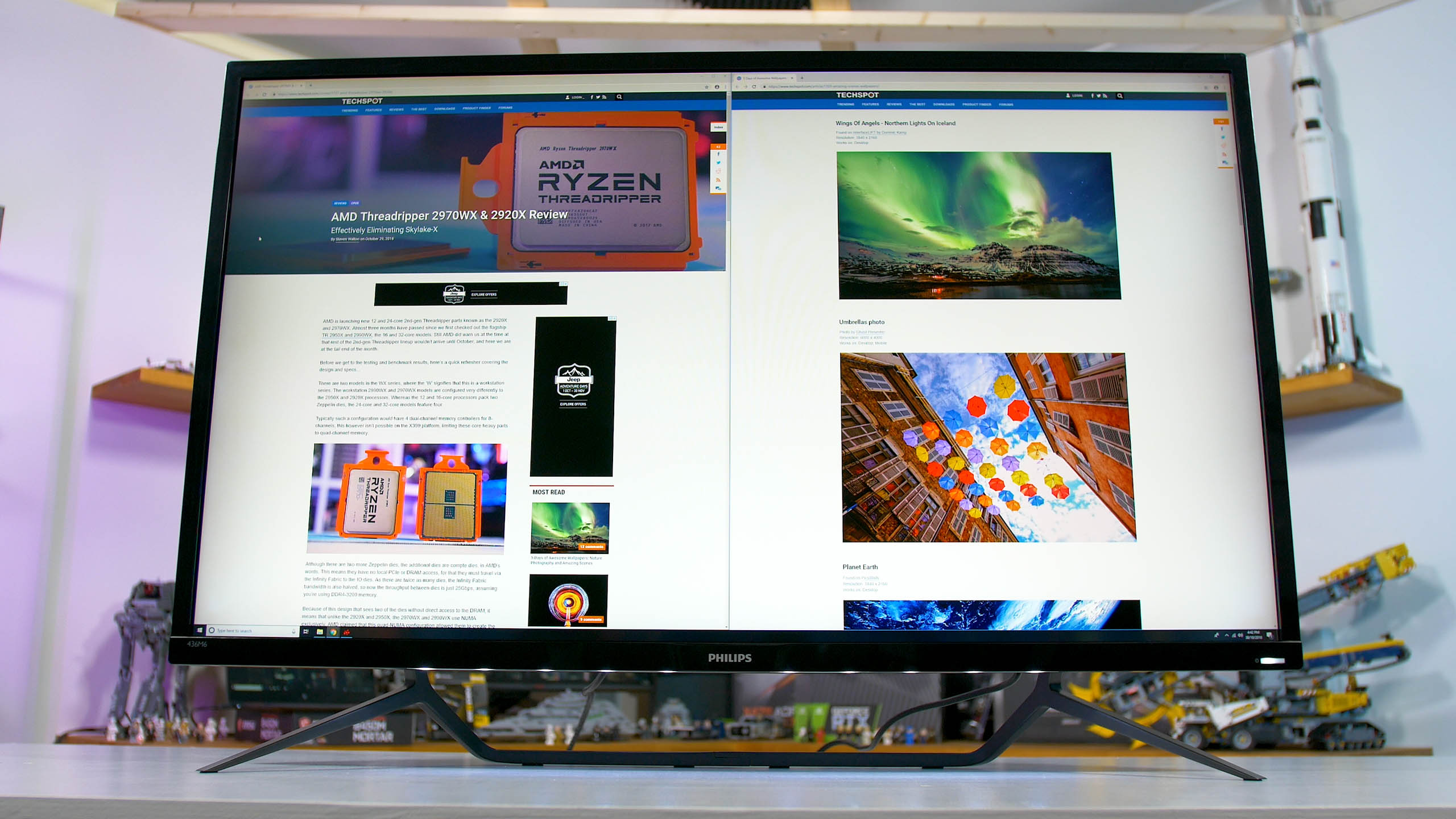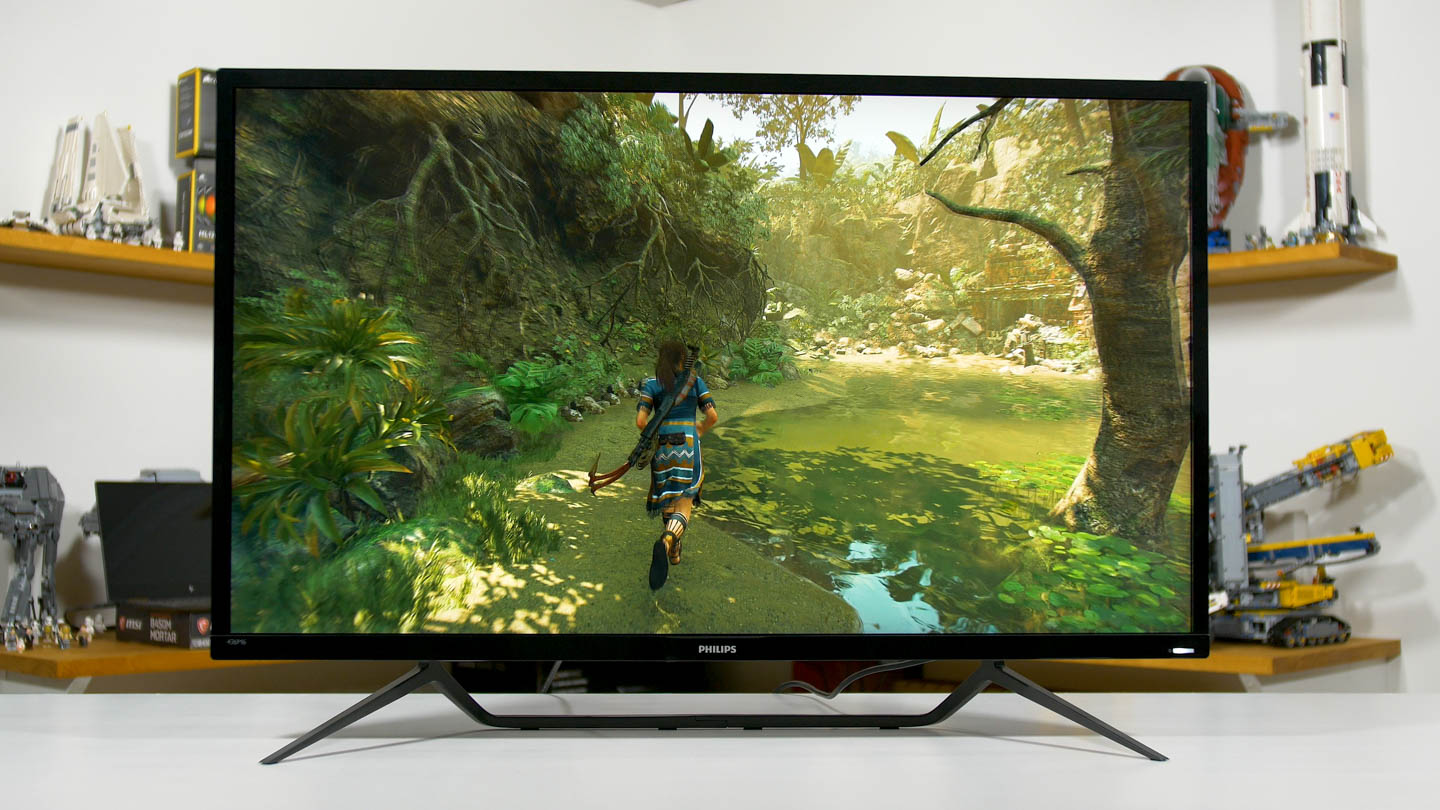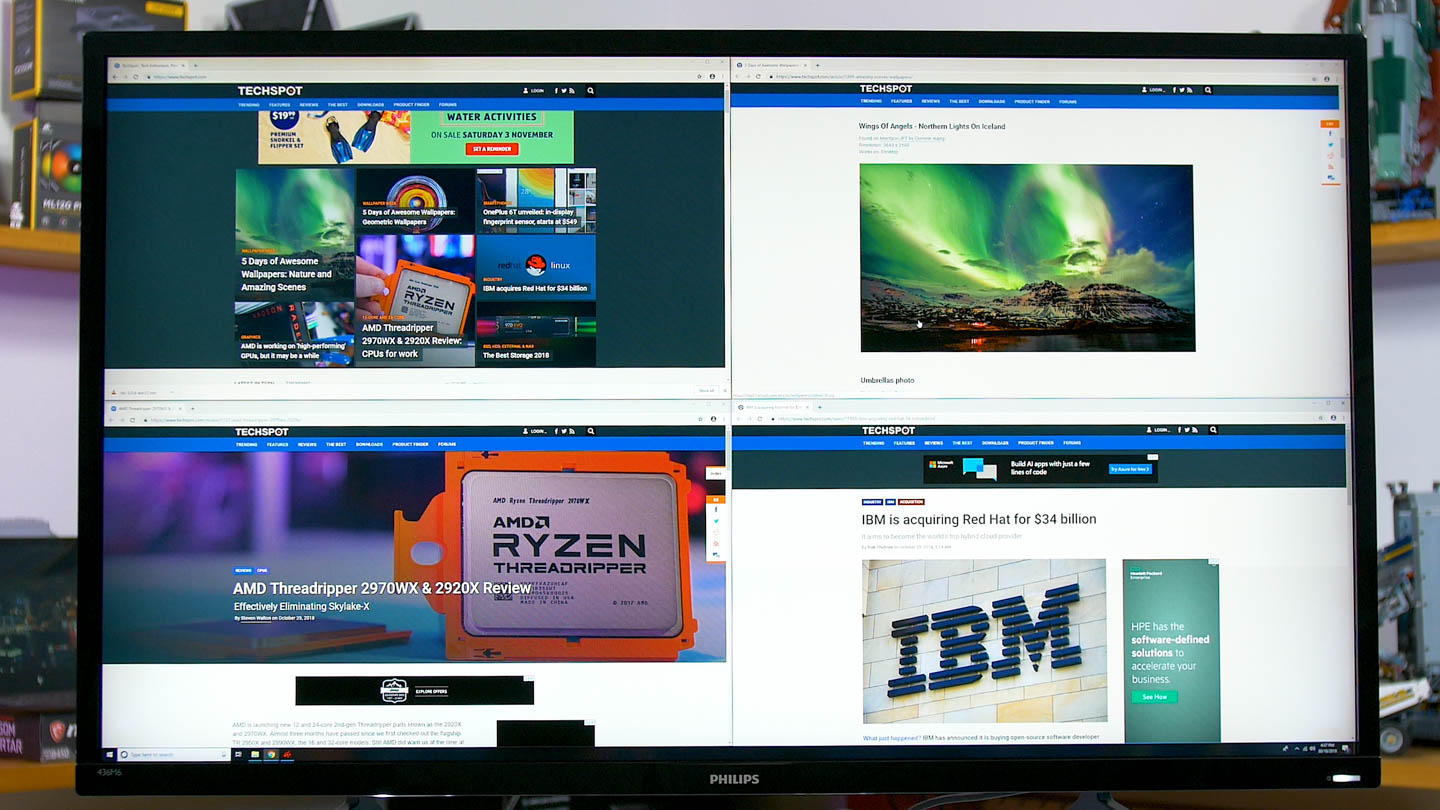Today we're looking at a really ridiculous product, the Philips Momentum 43. Also known as the 436M6VBPAB, the Momentum 43 is a 43-inch 4K HDR "monitor." It's not a TV according to Philips, but a monitor, so apparently they think some people are interested in such a massive display for their PC.
This thing is pretty big, and I'll talk a bit more about the size later. But first, a couple of important specs: this 43" 3840 x 2160 panel uses VA technology with a Quantum Dot film and it sports DisplayHDR 1000 certification, plus you get adaptive sync a.k.a. FreeSync, though in a rather narrow 48 to 60 Hz range.
With a 48Hz minimum, we're not getting low framerate compensation (or LFC) and as a result, we're not getting the full benefit of FreeSync. It's also the reason why the Momentum 43 is not advertised as a FreeSync 2 HDR panel: it fails the certification process for FreeSync 2 as it doesn't support LFC. This is despite the display boasting full DisplayHDR 1000 compliance.
The lack of FreeSync 2 and LFC is a bit of a bummer considering Philips is positioning this display as more of an entertainment or gaming focused unit. You'll be fine watching HDR movies or playing console games, but PC gamers are a bit left behind compared to the best 4K gaming displays out there.
This monitor is better suited to non-PC usage for another reason as well: it uses a non-standard subpixel structure, which causes a bit of text blurriness in Windows. It's definitely not the clearest 4K display I've seen, and this doesn't have anything to do with its size, as the pixel density here matches that of a 27-inch 1440p monitor. The BGR instead of RGB subpixel array is a non-issue outside of viewing text and documents in a PC operating system, so gaming is fine for example.
While Philips does see this as a gaming or entertainment display, there are some odd design choices that go against this marketing push. The panel only has a single HDMI port, so those with multiple consoles, or perhaps a console and a 4K Blu-ray player, can't plug in both at the same time without a switch or adapters. But then there are two DisplayPorts, one full sized and one mini, along with a USB-C input using DP alt mode. These are features you'd normally associate with a PC monitor rather than an entertainment display.
With a wide, two-pronged stand, the Momentum 43 looks more like a modern TV than a traditional monitor. The display is of average thickness with average bezels, nothing amazing for a monitor of this size, though the use of basic plastic on the front and rear keeps everything looking nice and minimal. In choosing this sort of design, the Momentum could be used for a number of applications without looking out of place: it could be a TV for console gaming, it could be a large office monitor, or it could be a monstrous PC gaming display.
Along the bottom edge you'll find Philips Ambiglow lighting, which is basically two RGB LED strips and some processing software that gets these strips to mimic the average colors currently on the display. In a dark room with white walls, this provides pleasant ambient lighting in some situations, and it works quite well - it's both responsive and accurate to what is being shown.
If you like this sort of ambient lighting it's worth experimenting with and it's definitely more useful than just a basic RGB strip. It can also be fully disabled, and in fact comes disabled by default, if you want a more traditional experience.
As for the on-screen display, Philips does include a directional toggle for easy navigation, but even easier than that is the remote they include. The remote is very basic and is mainly used for changing inputs and the volume of the in-built speakers, but it can also be used to flick through the on-screen settings, and that certainly helped for calibrating the display. Plus if you end up using the Momentum 43 as a TV, the remote is an essential inclusion.
It shouldn't come as a surprise, though, that the stand is very limited in that it only provides tilt adjustment. I would have been amazed if it included any other adjustments, so if you want to mount the screen higher up, or at an angle, you'll need to purchase a 200 x 200 VESA mount which is compatible with a display this size and weight.
Obviously one of the big drawcards of the Momentum 43 is its size, and this thing is certainly enormous. For gaming I use a 34-inch Acer Predator X34 ultrawide, which is already pretty wide as it is, but the Momentum 43 is a good 10cm wider while obviously being significantly taller as it's a 16:9 panel.
For productivity use I found the Momentum to be impractical for most tasks. It does have a few things going for it: a pixel density equivalent to a 27-inch 1440p display means you don't have to mess around with display scaling to read text at a typical desk viewing distance. It also gives you plenty of screen real estate, equivalent to four 21.5-inch 1080p monitors in a 2x2 grid, so you can snap apps to each corner and view 4 windows at once while still keeping things nice and visible, something you really can't do with a 32-inch 4K monitor or smaller.
But my main problem with this monitor for productivity tasks is that no work mode ever feels comfortable to use. If you're just viewing one massive 4K window, that's a waste of screen real estate and in many apps like Photoshop, you're eyes will be darting around the screen to taskbars on the left and right sides. In a split screen view, because the panel is flat, the edges are far away from your eyes and it's just not a great experience compared to a standard dual screen setup where you'd angle the screens for optimal viewing of each one. And then with one window in each corner, nothing important is in the center of the screen, and the center is the most easily viewable part.
Where this size really shines is for entertainment, which is exactly what Philips markets the display for. When you chuck a 43-inch screen at arm's reach on a desk, it's truly enormous, occupying a massive amount of your field of view. Compared to a standard 21:9 ultrawide monitor, the major advantage is in its height; the Momentum 43 just engulfs your vision where an ultrawide doesn't provide the same level of vertical immersion.
That said, in a lot of games you'll have to adjust the field of view and the HUD positioning to ensure the main action is in the center of the display. I felt the best use of the Momentum 43 as a PC gaming display was in games that allow you to adjust things so that you're not just viewing a blown up image, but instead are getting more peripheral vision both horizontally and vertically. Not every game allows you to do that, or can do so without a fisheye effect, so it can be a mixed bag.
Would I personally use a 43-inch display for gaming? Probably not, considering my existing 21:9 display is actually useful as a productivity monitor and the extra size of the 43-inch Momentum doesn't always lead to better results in games. But I can definitely see the appeal for a massive display like this for some gamers, though it's more of a niche thing.







